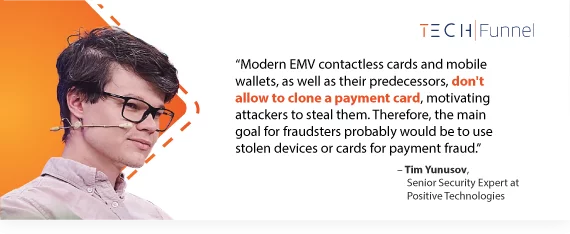Considering the convenience, speed, and ease, electronic money, especially using mobile payment options, is gaining increasing popularity in today’s always-on world. A significant increase in the use of mobile payment systems and digital wallets has been seen across the globe. However, mobile payment security has not been focused on to the extent of this widespread usage, leading to digital wallets and mobile payments still facing risks when the users lack awareness about fraudulent practices.
What are Mobile Payments?
Mobile payments are all the payments you make with your mobile device be it through mobile wallets or online mobile money transfers. Mobile payments can be used to pay for goods or services.
Mobile Payment Security Challenges
Despite the increasing demand for mobile payments, there is still hesitation among both businesses and end-users to fully adopt the technology due to security-related concerns.
Today’s cybercriminals and fraudsters employ increasingly sophisticated techniques to procure sensitive and personal data. Hence, these concerns are not misplaced.
Mobile payments are associated with several security risks. Here’s a list of some of the common mobile payment security risks:
1. Applications with security flaws
Many security risks in an application are found in the programming of the app when the app creators fail to follow a secured-by-design approach. Besides this, some vulnerabilities may also be discovered once the app goes live.
2. No payment security when the phone is lost
Smartphones today, are all-in-one devices. In addition to easy payment options, there’s also personal information on it including contact information for you and others in your phone book, names, personal photos, social media connections, and so on. Through various payment apps, mobile wallets, online banking apps, and much more, phones also give access to bank accounts, debit cards, and credit cards.
If you lose your phone in a store, restaurant, or crowded place, all your information is available easily. The details of banking and mobile payments are thus at risk, which can result in fraud.
Tim Yunusov, a senior expert with Positive Technologies, says lost-and-stolen fraud is among the most popular types of fraud affecting modern payment cards. In these attacks, when people lose a phone or card, there’s a gap when the card isn’t yet blocked during which fraudsters can buy goods and services.
3. Inappropriate usage
Regardless of how secure your mobile phone is, the way you use your mobile phone can pose a security risk. Using your mobile phone’s website, fraudsters can make purchases and payments. Google Pay and Apple Pay are popular for making mobile payments on Android and Apple phones, which is highly risky once encryption is decoded.
4. Exposed mobile wallets
As mobile payment options became available, several payment apps emerged. A debit or credit card must be entered into the mobile wallet for these applications to work.
During the application process, details like the card number, VCC number, expiration date of the card, etc. are encrypted through codes.
For making payments, the providers of mobile wallets also use a randomly generated verification number that is not visible to the merchants while transactions are being made. This means the data linked to your credit cards is also available on the multiple mobile wallets that you chose to use.
5. Cloned applications
Is your mobile phone set up with an authentic banking or mobile wallet application? Could it be a clone? Many app clones offer secure payment options exactly akin to the original apps.
If users use these clones of authentic apps and register their banking information with them, it will be easier for the criminals to commit fraud using details of their credit cards, debit cards, and other personal information.
Criminals can easily access such clones due to their poor security features.
6. Making use of a variety of software options
Mobile phones also use a variety of hardware and software systems, just as do laptops and desktops. In some countries, iOS and Android are still used by users of the older versions. Security issues can arise because of this. The devices are not well-supported by the latest mobile security technologies, which makes them attractive to hackers and fraudsters.
Even if your mobile applications are secure, your device may not meet the security standards needed for mobile wallet transactions, thus making it risky for the users.
7. Risks related to networks
Older mobile devices that contain mPOS applications are more vulnerable to fraud and more likely to be hacked by criminals. Fraudsters use increasingly sophisticated methods to acquire sensitive information from businesses as they now have technology capabilities far more advanced than before.
Even though data breaches at large organizations tend to dominate the headlines, small-to-medium-sized businesses are more vulnerable to fraudsters, as they do not invest in security measures that are robust enough to protect their customers.
How to Build Mobile Payment Security to Avoid Fraud
When it comes to mobile payment security, there are certainly some concerns to consider. However, that doesn’t mean you should abandon mobile payment options for a business altogether. With mobile payments, you can take a variety of security measures to reduce fraud risk. Here are some tips.
-
Sensitive information shouldn’t be sent over public Wi-Fi
Securing internet networks for your business’ POS applications is critical. If you don’t offer secure networks for your customers’ devices on your Wi-Fi networks, you stand to lose trust and suffer severe harm to the business. When it comes to hacking mobile devices, cybercriminals have advanced technical know-how.
People may be wary of sending sensitive data such as financial information over public Wi-Fi networks due to the risk involved because information transmitted over these networks is accessible easily through the network.
-
Use VPN for mobile payment security
If you absolutely must use a public network, please ensure that your customers’ information is encrypted properly. You can have them access the internet securely and safely with a VPN.
Financial transactions are encrypted end-to-end with mobile payment apps. When the financial data arrives at the other end, it is decrypted. Securing your customers’ financial data on unsecured networks with a VPN can be the way to protect them.
-
Strengthen your passwords
Be sure to always lock your phone. Your phone can be easily accessed and the sensitive financial information on it stolen if it is unlocked. Consider using strong passwords and utilizing other security features, such as fingerprint recognition, iris scanning, and facial recognition, on your device.
-
Turn on anti-theft features
Mobile phones can get lost all the time. Using your phone’s built-in anti-theft protection tools, you can lock a stolen or lost device so that an unauthorized person cannot use it. If you want to remotely erase the data on the device, including contacts, banking app data, mobile payment app data, emails, and photos, you can do that as well.
-
Make sure your mobile payments are safe
Whenever you use a mobile payment platform, make sure to use only trusted platforms. To add information to your smartphone, make sure you have the latest version of the software. Verify that third-party platforms such as PayPal are trusted and verifiable.
Final Thoughts
You can protect your business and customer data with the above solutions. Your customers must be educated and given the information and tools they need to make sound decisions.
You can also make mobile payment security a mandatory practice to ensure the safety and security of your corporate finance data. Protecting your employee’s and customers’ mobile devices as much as possible against fraudsters is imperative in the digital era.







